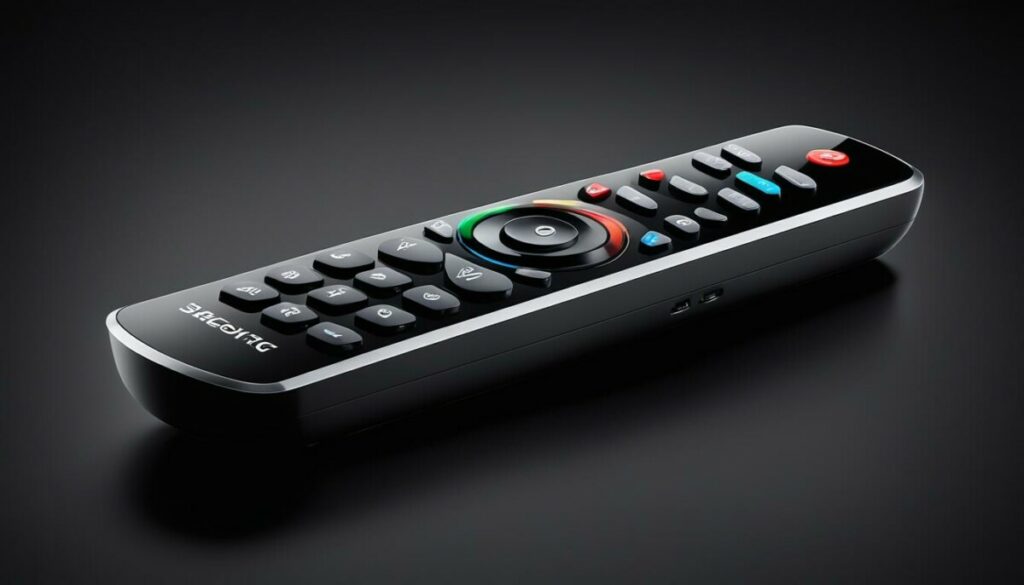Last Updated on 4 months by Francis
Have you ever wondered how your TV remote control communicates with your television? The answer lies in infrared (IR) remote sensors. These sensors play a vital role in transmitting commands from the remote control to your electronic devices, such as TVs, stereos, DVD players, and game consoles.
Infrared remotes use light signals that are transmitted from a transmitter to a receiver in the electronic device. The front of the remote control has sensors that detect the infrared light and decode the instructions. This technology works by transmitting an electromagnetic signal with a wavelength longer than visible light. The signal is pulsed in binary code, and each command has a specific code. The device receiving the signal then transmits the code to the microprocessor, which interprets and executes the instructions.
- Infrared (IR) remote controls use light signals transmitted from a transmitter to a receiver in electronic devices.
- IR remotes have sensors on the front to detect the infrared light and decode the instructions.
- The signal transmitted by IR remotes is pulsed in binary code, with each command having a specific code.
- The electronic devices receiving the signal have sensors that transmit the code to the microprocessor, which interprets and executes the instructions.
- IR remotes are widely used in devices such as TVs, stereos, DVD players, and game consoles.
Contents
Types of IR Remotes

When it comes to IR remotes, there are various types available in the market. From basic models to high-end options, these remotes offer different features and functionalities to suit different needs. One of the key differentiators among IR remotes is the number of IR transmitters they have.
Basic IR Remotes: The most basic IR remotes usually come with a single IR transmitter. These remotes are simple in design and serve the basic purpose of sending IR signals to control electronic devices.
Advanced IR Remotes: On the other end of the spectrum, there are advanced IR remotes that offer multiple IR transmitters. These remotes often feature two to four transmitters, allowing for signals to be sent at different angles. This eliminates the need to point the remote directly at the electronic device for it to work.
Benefits of Multiple IR Transmitters:
- Improved Range: Multiple IR transmitters enhance the range of the remote, allowing you to control your devices from a greater distance.
- Reduced Line-of-Sight Limitations: With multiple transmitters, you don’t need a clear line of sight between the remote and the device. The signals can bounce off walls and other surfaces, making it more convenient to control your devices.
Additionally, some IR remotes also come with separate IR receivers that can be placed outside of cabinets or hidden areas. These receivers ensure that the IR signals are transmitted to the devices inside, even when they are stored away.
Example of IR Remote Types:
| IR Remote Type | Number of IR Transmitters | Features |
|---|---|---|
| Basic IR Remote | 1 | Simple design, standard functionality |
| Advanced IR Remote | 2-4 | Multiple transmitters, improved range, reduced line-of-sight limitations |
| IR Remote with Separate IR Receivers | 1 | Separate IR receivers for devices stored away |
Having multiple IR transmitters and separate IR receivers can greatly enhance the usability and convenience of IR remotes, providing a seamless control experience for your electronic devices.
Limitations of IR Remotes
Despite their convenience, IR remotes have some limitations that users should be aware of. These limitations primarily revolve around the range and line-of-sight issues associated with infrared technology.
The range of IR remotes is typically around 30 feet, which is sufficient for most home setups. However, it is important to note that this range can vary depending on the specific remote and the environment in which it is used. Factors such as obstructions and interference can affect the effective range of IR signals.
One of the main limitations of IR remotes is their reliance on a clear line of sight between the transmitter and the receiver. Infrared signals are blocked by any objects that interrupt the direct path between the remote and the device being controlled. This means that if there are furniture, walls, or even closed cabinet doors between the remote and the device, the signals may not reach the destination.
While some remotes with multiple transmitters partially address the line-of-sight issues by allowing signals to be sent at different angles, they do not completely eliminate this problem. Users still need to ensure that there is an unobstructed path for the signals to transmit properly.
“The range and line-of-sight limitations of IR remotes can sometimes be frustrating, especially in larger rooms or setups where devices are stored in cabinets. Users need to be mindful of these limitations and position themselves within range and ensure a clear line of sight for effective remote control.”
In summary, the limitations of IR remotes include their limited range and the requirement for a clear line of sight. These limitations can be overcome to some extent by using remotes with multiple transmitters or by strategically positioning devices and removing any obstacles. However, users should be mindful of these limitations and make the necessary adjustments to ensure seamless remote control functionality.
Comparing the Range of IR Remotes
| IR Remote Model | Range (Approximate) |
|---|---|
| Samsung BN59-01259E | 30 feet |
| Logitech Harmony Elite | 100 feet |
| Sony RMVLZ620 | 50 feet |
Solutions to Line-of-Sight Issues

To address the line-of-sight issues commonly experienced with standard infrared (IR) remotes, manufacturers have developed innovative solutions. These solutions include the use of separate IR receivers and RF remote controls, providing users with greater flexibility and convenience.
Separate IR Receivers
To overcome the limitations of traditional IR remotes, manufacturers have introduced separate IR receivers. These receivers can be placed outside of cabinets or concealed spaces, allowing devices inside to receive IR commands even when stored away. By extending the range of IR signals, separate receivers provide a reliable solution to line-of-sight issues.
RF Remote Controls
An alternative solution to line-of-sight problems is the use of RF remote controls. RF stands for Radio Frequency, and these remotes transmit commands as radio waves to a base unit. The base unit then converts the radio waves to IR signals, which are subsequently transmitted to the electronic device. The advantage of RF remote controls is that they are not limited by line-of-sight restrictions. They can transmit signals even through walls and into other rooms, offering greater convenience and versatility.
RF remotes are particularly beneficial in situations where the electronic devices are concealed behind closed cabinets or walls. With RF technology, users can control their devices from anywhere in the room without the need to aim the remote directly at the devices.
| Pros of Separate IR Receivers | Pros of RF Remote Controls |
|---|---|
| Extends the range of IR signals | Transmits signals through walls and ceilings |
| Allows devices to receive IR commands even when stored away | Greater convenience and versatility |
| Can be placed outside of cabinets or concealed spaces | No need to aim the remote directly at the devices |
Both separate IR receivers and RF remote controls provide effective solutions to line-of-sight issues, enhancing the overall usability and convenience of remote control technology.
Replacing and Programming IR Remotes
When your remote controls go missing or need to be replaced, programmable universal IR remote controls provide a convenient solution. These remotes can be easily programmed with the appropriate set of IR codes for specific electronic devices, eliminating the hassle of searching for specific codes.
Programmable universal remote controls offer a user-friendly way to replace remote controls without any complicated setups or configurations. Whether it’s your TV, stereo system, or DVD player, you can easily program the universal remote to control all your devices with just one click.
Programming these remotes is a breeze. Codes can be downloaded from the device manufacturer’s website or entered manually using preprogrammed code sets. This flexibility ensures that you can quickly get your programmable universal remote up and running with your devices.
To give you a better understanding of how to replace and program your remote controls with ease, here’s a step-by-step guide:
- Identify the make and model of the device you want to control with the programmable universal remote.
- Visit the manufacturer’s website or refer to the user manual to obtain the IR codes for your specific device.
- Enter the IR codes into the programmable universal remote by following the instructions provided.
- If the codes are not available online, refer to the preprogrammed code sets that come with the remote, usually organized by device type and brand. Find the corresponding code set and use it to program your remote.
- Test the remote to ensure it controls your device effectively. If not, try entering different codes until you find the correct one.
- Enjoy the convenience of your newly programmed universal remote control, effortlessly managing multiple devices with just one remote.
By utilizing programmable universal remote controls, you can simplify your entertainment setup and eliminate the need for multiple remotes cluttering your living space. Experience the convenience and versatility of a single remote control that puts all your devices at your fingertips.
IR Blasters and IR Extender Cables

IR blasters and IR extender cables are two solutions that offer additional flexibility and convenience when it comes to controlling your electronic devices.
An IR blaster is a small device that functions similarly to an IR remote control. It sends IR signals and commands directly to other gadgets, allowing you to control various devices without the need for multiple remote controls. For example, the Logitech Harmony Hub is a popular IR blaster that can be integrated with voice control systems like Alexa, enabling you to control TVs, soundbars, gaming consoles, and more with just a few vocal commands.
On the other hand, IR extender cables are connecting cords that extend the reach of your IR signals. They can be particularly useful if you want to control devices that are located away from your main entertainment setup or are hidden inside cabinets. These cables connect to an IR device on one end and feature an IR transmitter on the other end. By extending the IR signal, you can control devices that are not within the direct line of sight of your remote control.
For example, gaming consoles like the Xbox and streaming devices like the Amazon Fire TV Cube often come with IR extender cables. These cables allow you to place the console or streaming device inside a cabinet or behind your TV while still maintaining control using your remote.
Here is an image to illustrate the use of IR blasters and IR extender cables:
By incorporating IR blasters and IR extender cables into your setup, you can enhance the functionality and convenience of your remote control system. Whether it’s controlling multiple devices with an IR blaster or extending the reach of your IR signals with an extender cable, these solutions offer flexibility and simplify the way you interact with your electronic devices.
Advantages of IR Remotes

Despite their limitations, IR remotes offer several advantages. They provide a simple and intuitive way to control electronic devices without the need for complex setups or additional equipment.
With just a few clicks of the buttons, you can effortlessly change channels, adjust volume, and navigate menus, making it a user-friendly option for individuals of all ages.
Additionally, IR technology is widely adopted, making IR remotes compatible with a wide range of devices in the market. This widespread compatibility ensures that IR remotes can be used with various electronic devices without the need for specific compatibility issues.
Simplicity and Ease of Use
One of the key advantages of IR remotes is their simplicity and ease of use. Unlike complex universal remotes or smartphone apps, IR remotes have a straightforward interface with clearly labeled buttons for each function.
Whether you want to turn on the TV, change the input source, or adjust the sound settings, you can do so with a single press of a button. The intuitive design of IR remotes eliminates the need for navigating complicated menus or remembering complex gestures, ensuring a hassle-free user experience.
Widespread Compatibility
Another notable advantage of IR remotes is their widespread compatibility. IR technology has been widely adopted by electronic device manufacturers, including major brands like Samsung, LG, Sony, and Panasonic.
This means that regardless of the brand or model of your electronic devices, chances are they are compatible with IR remotes. Whether you have a TV, audio system, DVD player, or gaming console, an IR remote can easily communicate with these devices, offering a versatile solution for controlling all your devices with a single remote.
The Future of Remote Control Technology
The world of remote control technology is constantly evolving, paving the way for exciting advancements and innovations. As we look ahead, it’s clear that the future holds great potential for transforming the way we interact with our electronic devices.
One significant area of development is the emergence of alternative remote control technologies such as Bluetooth and Wi-Fi. These wireless communication technologies offer several advantages over traditional infrared (IR) remotes.
Bluetooth enables remote control functionality using short-range radio waves. It provides a greater range, allowing users to control their devices from a distance without the need for a direct line of sight. This opens up new possibilities for controlling devices in different rooms or from any corner of a large living space.
Wi-Fi, on the other hand, offers even more extensive coverage and reliability. With Wi-Fi-enabled remote controls, users can connect to their devices via a home network, enabling control from anywhere within the network range. This wireless connectivity allows for seamless integration with other smart devices, enhancing the overall user experience.
One of the most notable trends in remote control technology is the increasing popularity of smart home integration. With the rise of smart devices and home automation systems, remote controls are evolving to become an integral part of the connected home ecosystem.
Smart home integration allows users to control multiple devices, appliances, and systems using a single remote control or a mobile app. This level of convenience and centralized control simplifies the user experience and eliminates the need for multiple remotes or complex setups.
Another exciting development is the integration of voice control technology into remote controls. Voice-activated remotes, such as those powered by virtual assistants like Amazon Alexa or Google Assistant, enable users to control their devices using simple voice commands.
This hands-free approach to remote control technology is not only convenient but also offers a more intuitive and natural way of interacting with our devices. Voice control, combined with advanced artificial intelligence algorithms, allows for personalized and context-aware interactions, further enhancing the overall user experience.
“The future of remote control technology is bright, with advancements in wireless communication, smart home integration, and voice control shaping the way we interact with our devices.”
In summary, the future of remote control technology is full of promising advancements. From the adoption of alternative wireless technologies like Bluetooth and Wi-Fi to the integration of smart home features and voice control capabilities, our remote controls are becoming more powerful, versatile, and user-friendly. As technology continues to evolve, we can expect to see even more exciting developments that will revolutionize the way we control and interact with our electronic devices.
Conclusion
While infrared remote sensors are not interchangeable in the traditional sense, infrared (IR) remotes offer compatibility with a wide range of electronic devices. This is made possible by the widespread adoption of IR technology in the industry.
To address the limitations of IR remotes, manufacturers have introduced various solutions to enhance the user experience. These include the incorporation of multiple transmitters in higher-end remotes, allowing for signals to be sent at different angles and reducing the need for direct line-of-sight. Additionally, separate IR receivers can be placed outside of cabinets, enabling devices stored inside to receive IR commands. RF remote controls, which transmit signals as radio waves to a base unit, further overcome line-of-sight issues by extending the range of control.
The future of remote control technology holds exciting advancements that will revolutionize how we interact with our devices. As alternatives to traditional IR remotes, technologies like Bluetooth and Wi-Fi are being integrated to offer greater range, improved reliability, and enhanced functionality. The rise of smart home integration and voice control further augments the capabilities of remote control systems.
In conclusion, while interchangeable remote sensors may not be feasible, the evolution of remote control technology continues to provide innovative solutions to overcome limitations and enhance user experiences. With ongoing advancements, the future promises exciting possibilities for remote control technology, enabling us to interact with electronic devices in even more seamless and intuitive ways.
FAQ
Are infrared sensors on remotes interchangeable?
No, infrared sensors on remotes are not interchangeable in the sense that any sensor can be used with any remote control.
What types of IR remotes are available?
IR remotes come in various types, ranging from basic models with one IR transmitter to higher-end ones with multiple IR transmitters.
What are the limitations of IR remotes?
The range of IR remotes is typically around 30 feet, and they require a clear path for the signals to transmit properly between the transmitter and the receiver. Line-of-sight issues can be a limitation, as any objects blocking the infrared signals can prevent the remote from working.
What are the solutions to line-of-sight issues with IR remotes?
Manufacturers have developed solutions such as separate IR receivers that can be placed outside of cabinets, enabling devices inside to receive the IR signals even when stored away. Another solution is the use of RF remote controls, which transmit commands as radio waves to a base unit.
How can I replace and program IR remotes?
Programmable universal IR remote controls offer a solution for replacing remotes. These remotes can be programmed with the appropriate set of IR codes for specific electronic devices. Codes can be downloaded from the device manufacturer’s website or entered manually using preprogrammed code sets.
What are IR blasters and IR extender cables?
IR blasters send IR signals and commands directly to other gadgets, while IR extender cables extend the IR signal to another device. IR extender cables are often included with gaming consoles and streaming devices.
What are the advantages of IR remotes?
IR remotes provide a simple and intuitive way to control electronic devices without the need for complex setups or additional equipment. Additionally, IR technology is widely adopted, making IR remotes compatible with a wide range of devices in the market.
What does the future hold for remote control technology?
The future of remote control technology is continuously evolving, with advancements being made to overcome the limitations of IR remotes and improve the overall user experience. This includes the development of alternative remote control technologies such as Bluetooth and Wi-Fi, as well as smart home integration and voice control.
Are infrared remote sensors interchangeable?
Infrared remote sensors on remotes are not interchangeable in the sense that any sensor can be used with any remote control.








